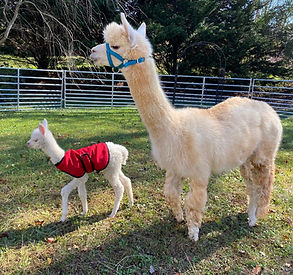Fun Facts
About Alpaca

Alpaca
-
A father Alpaca is called the Sire
-
A mother Alpaca is called the Dam.
-
A baby Alpaca is called a Cria. (Average birth weight of 8 – 20 lbs.)
-
Alpaca gestation period is 11 - 12 months.
-
Alpaca give birth to only one cria at a time.
-
Adult Alpaca weigh100 - 200 lbs. and are 4.5 – 5.5 ft tall (to top of head)
-
The alpaca digestive system is unique. An alpaca is not a true ruminant because they have only one stomach with three compartments. True ruminants have 4 compartments. However, like true ruminants they do chew their cud.
-
Alpacas do not have hoofs. They are two-toed with toenails and soft foot pads. Their padded feet are gentle on terrain so they can graze land without destroying roots.
-
Alpacas are highly social animals who need companionship and to live in ‘herds’ of at least 3.
-
Alpacas constantly communicate with each other through body posture, tail and ear movements, and a variety of sounds. The sound heard most often is a soft humming, a mild expression befitting a such gentle animal.
-
Most Alpacas do not particularly like to be touched especially by strangers.
-
Alpacas are amazingly alert animals who can fairly quickly be trained to halter and lead. Ours have also been trained to (usually) not spit.
-
Alpacas are members of the camelid family. They are very closely related to llamas. In fact, alpacas and llamas can produce fertile offspring.
-
Alpaca fiber (fleece) is valued as one of the finest natural fibers. Alpaca fiber is naturally hypoallergenic (as it doesn't contain any lanolin). It is naturally water repellent and fire resistant. Alpaca fleece is also stronger than mohair, finer than cashmere, softer than cotton, smoother than silk, and warmer than wool or goose down.
-
Alpaca manure is valued as well. It is nature's richest fertilizer. It is low odor, high in nutrients, is naturally time released, improves soil, holds moisture, and has the most balanced content of any natural fertilizer.


